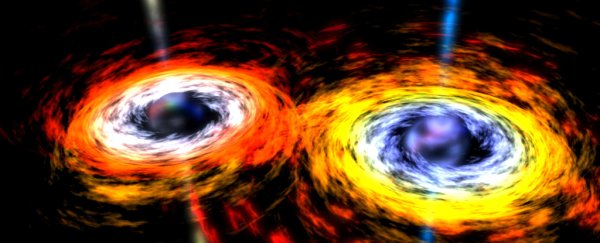In February, astronomers made a monumental discovery. Almost 100 years after Albert Einstein first predicted them, researchers detected gravitational waves - ripples in space time that had radiated out from the merging of two black holes.
It was a striking confirmation of Einstein's general theory of relativity - but in an unexpected twist, the discovery has also provided the first tantalising evidence that his theory breaks down at the event horizon of black holes.
Since February, the Laser Interferometer Gravitational-Wave Observatory (LIGO) has observed three gravitational wave events in total. And now researchers have pored over this data, and claim they've found evidence of 'echoes' in the waves that defy Einstein's predictions of black holes.
For now, the new claims have been published on ArXiv.org, where they can be examined by the rest of the physics community before being submitted for peer-review - so there's a very real possibility that these echoes could go away with more scrutiny of the data.
And the evidence so far falls short of the crucial 5-sigma error margin, which is the gold-standard in the physics world that means there's a one in 3.5 million chance that the result could be a fluke.
But if further research shows that these 'echoes' are really there, it would be a huge day for physics. It's already thought that general relativity breaks down at the centre of black holes, but this would show that it fails at their edges, too. And that could herald the birth of new physics.
"The LIGO detections, and the prospect of many more, offer an exciting opportunity to investigate a new physical regime," Steve Giddings, a black-hole researcher from the University of California, Santa Barbara, who wasn't involved in the study, told Zeeya Merali at Nature.
If the echoes disappear, general relativity would have just withstood yet another test. For decades, physicists have been attempting to poke holes in the theory, trying to find ways it could be more compatible with quantum mechanics, but so far, Einstein's original version has held up incredibly well.
But before we get too carried away, what are these 'echoes', and what do they have to do with general relativity?
It all comes down to something called the black hole information paradox.
According to Einstein's general theory of relativity, anything that crosses a black hole's event horizon should disappear, with no trace left behind. The traditional thinking is that not even light can escape a black hole, hence the name 'black'.
More recently, though, researchers have questioned that idea. Because according to quantum mechanics, matter swallowed by a black hole would actually leave a trace of itself on the outside.
So how can an event horizon satisfy both general relativity (and destroy everything that passes its boundary) and quantum mechanics (leave some trace of it)?
This is one of the biggest problems in physics, and scientists still don't have an answer.
One explanation is the firewall hypothesis, which was proposed in 2012, and suggests that there's a ring of high-energy particles surrounding a black hole's event horizon that burns up any matter that passes through.
Physicist Stephen Hawking has a different idea - that black holes are surrounded by soft 'hair'. The 'hair' is low-energy quantum excitations that store a signature pattern of everything that's been sucked up by a black hole.
Regardless of which hypothesis you think is the most convincing, the overarching message is the same: instead of the clean event horizon predicted by general relativity, black holes might be 'fluffier' than we imagined.
The only problem is we've had no way to actually test any of these ideas, until LIGO detected gravitational waves earlier this year.
Now, with their latest data in hand, a team of international researchers has proposed a way to measure what's going on around black holes.
The prediction is that, if the edges of black holes really do defy general relativity and are fuzzy, then a series of echoes should be released after an initial gravitational wave burst.
That's because the team predicts the fuzziness surrounding a black hole will act kind of like a hall of mirrors, trapping some of the gravitational waves escaping the black hole merger and bouncing them around for a bit, so only a few escape at a time, meaning they would have hit LIGO slightly later.
According to the team's calculations, these echoes would have been detected by LIGO at 0.1, 0.2 and 0.3 seconds after the initial gravitational wave burst, and that's exactly what the data show.
Not only after the first gravitational wave burst detected in February, but all three events seen since.
Of course, three gravitational wave bursts is still a pretty tiny sample size. And there's a chance that these echoes are just some kind of background noise - around a 1 in 270 chance, to be precise, or 2.9 sigma - but further observations should help narrow down those odds.
"The good thing is that new LIGO data with improved sensitivity will be coming in, so we should be able to confirm this or rule it out within the next two years," lead research Niayesh Afshordi told Nature.
Even if the echoes can be confirmed, they still don't provide any insight into what kind of fuzzy boundary black holes might actually have, so we've got a long way to go before that information paradox is solved.
But one thing's for sure: the physics discovery of the year just got even more tantalising.
You can read the full study on arXiv.org.
